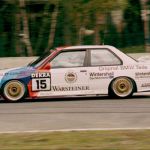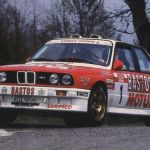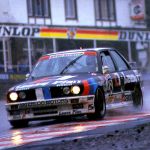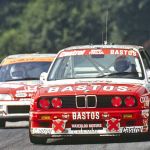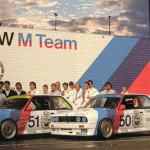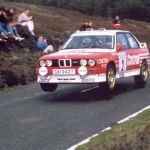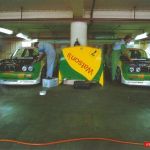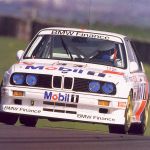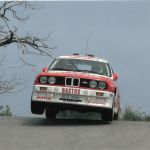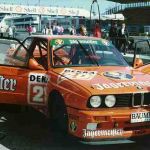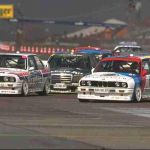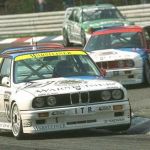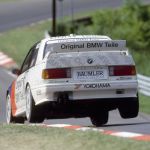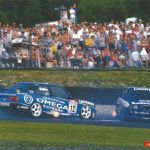Pure intentions, pure handling, pure sound – The legendary E30 M3

When no less a man than Jean Alesi describes a car as the sweetest-handling machine he can think of, you sit up and take notice. Here is a man whose Quixotic career was defined by his passion for making cars go faster than they had any right to do – usually because they should never have left the designer’s notepad. Small wonder, therefore, that he appreciates the work of unbridled genius that is the BMW M3.
Now I’ll have to come out at this point as a BMW agnostic, although the true believers among you will have guessed that already because I didn’t say the ‘BMW E30 M3’ – meaning the car built and raced from 1987 to 1992. Yet there really is only one BMW M3: a pocket monster that was purpose-built from the ground up to win. Anything. Anywhere. Any time.
In the mid-eighties the BMW make wasn’t doing too badly in the world of Group A: the slinky 635CSI had successfully morphed from laid-back boulevard cruiser to world-class racer and, in the hands of drivers like Hans Stuck, James Weaver and Gerhard Berger, combined sideways action with a spectacular soundtrack.
But ‘not doing badly’ wasn’t really BMW’s style. There was going to be an all-new touring car world championship in 1987 and the Munich marque was ravenous to win it. A decade earlier it had built the sweeping 3.5 CSI ‘Batmobile’ to crush the Cologne Capri and give Porsche a fright. Then it had astonished the world with the turbocharged 320i Turbo ‘flying brick’. Finally it built an all-out sports car in the luscious form of the M1, but now a bona fide world title was at stake.
So it was that in 1986 the racing department got hold of a baby 3-series model… and threw away every last bit except the bonnet.
The body was remade wider, lighter and stiffer: all muscle and no fat. While that was going on the engine was forged with Elvish craft by taking the old 4-cylinder unit from a prehistoric BMW 2002 and then stuffing it full of all the valve and cylinder head genius that could be stripped from the mighty M1. A raucous, breathy little 2.3-litre tornado emerged from this Frankenstein laboratory: both sublimely and dementedly rabid, yet strong enough to pull for a 24-hour endurance race or international rally.
Most manufacturers might have blanched at the cost of building a completely new car, particularly when Group A regulations stipulated that a minimum of 5000 road cars had to be built to the same specification. But not BMW. In an instant it created the most desirable two-door saloon car ever seen on the highway, because within four months it had managed to build these 5000 nuggets of genius – and the works cars were on the grid at Monza for the start of the 1987 WTCC.
This was grown-up racing with the likes of rumbling Holdens, sinewy Alfas, indecently fast Volvos and the mighty Ford RS500. The big Holden rumbled through 500km around the old royal park to take the win but there was little doubt that the M3 had everyone on the back foot: this was a Tasmanian Devil on wheels.
The next two rounds fell to the little BMW’s relentless assault outright, but despite a fightback from Ford for overall wins, the M3 wasn’t even competing in the same race – its little fireball of an engine put it in the class below, so no matter what the big boys did the points were heading to Munich. Yet for all that BMWs took outright victory at two of the three marquee races – the Spa 24 Hours and Britain’s Tourist Trophy.
Only at Bathurst did the M3’s charge get shouldered aside in that most contentious of races on the mountain. Yet while arguments raged between Ford and Holden over who had actually got claim on the winner’s laurels, Jim Richards and the JPS M3 cleaned up in Division 2, adding to BMW’s unstoppable points tally, from which Roberto Ravaglia emerged as the drivers’ champion.
It was mission accomplished for BMW, crowned as the world masters of touring car racing – and a good thing too, because these epic battles between big-name drivers in high street cars was recognised as a threat to the popularity of Formula One. After one season the series was snuffed out – although there was still much work to be done by the little M3.
In fact the WTCC title was just one of seven touring car championships claimed in 1987 – including the all-important European and German titles, making a triple crown for the works M Team. It also won two hillclimb championships, two rally championships and, outright, the Corsican round of the World Rally Championship.
The European championship still held out as the sport’s international blue riband series until the following year – again dominated by the M Team – and a combination of the staggering cost of developing a BMW beater together with the ongoing threat of accessible touring car racing against elitist Formula One saw the FIA snuff this series out too and send touring cars to domestic competition.
Nevertheless, even national touring car championships gained international following – particularly the German and British series. Global TV audiences and massive trackside crowds kept turning up and tuning in – and new challengers to the throne appeared. Audi built the elegant V8 Quattro, Mercedes built the mad-as-a-loon 190 Evos and Opel Cars used Irmscher muscle on its Omega minicab to try and tame the BMWs in their home series. Meanwhile the British got a bespoke 2-litre model at the start of the SuperTouring era – giving the late Will Hoy the title he deserved.
So it was that BMW kept tweaking the magic formula into the early 1990s, with each iteration being labelled as an ‘Evo’ – meaning that only 500 needed to be produced. The engine size crept up to 2.5 litres and numerous aerodynamic changes were made through the years – all reflected in the Evo 1, Evo 2 and Evo Sport road cars – and win piled on top of win.
Ultimately BMW achieved the greatest landmark of all: the most successful road racing car in history in terms of outright wins, never mind class wins or even championships. It is a record that can never, ever be beaten because M3s are still racing – and rallying and hillclimbing – at national and international events around the world.
That’s why there can only ever be one BMW M3. It was a car that required flameproof underwear to drive it rather than a designer suit. The name has lived on in the form of many heated-up ‘junior exec’ cars and some of them have been less mundane than others, but none were forged with the mania to win of the tiny, untameable original.
BMW M3 Record of Achievement
Circuit Racing Other Disciplines
1987 World Touring Car Championship 1987 European Hillclimb Championship
1987 Spa 24 Hours 1987 Spanish Rally Championship
1987 European Touring Car Championship 1987 Mitropa Rally Championship
1987 German Touring Car Championship 1987 Spanish Hillclimb Championship
1987 Austrian Touring Car Championship 1987 Tour de Course (WRC) Winner
1987 Swedish Touring Car Championship 1988 European Hillclimb Championship
1987 Spanish Touring Car Championship 1989 Belgian Rally Championship
1987 Swiss Touring Car Championship 1989 French Rally Championship
1988 European Touring Car Championship 1989 Italian Rally Championship
1988 Spa 24 Hours 1990 Spanish Rally Championship
1988 British Touring Car Championship 1990 Spanish Hillclimb Championship
1988 Asia-Pacific Touring Car Championship 1991 French Hillclimb Championship
1988 Australian Touring Car Championship
1988 Dutch Touring Car Championship
1988 French Touring Car Championship
1988 Finnish Touring Car Championship
1989 German Touring Car Championship
1989 Nürburgring 24 Hours
1989 French Touring Car Championship
1989 Swedish Touring Car Championship
1989 Italian Touring Car Championship
1989 Finnish Touring Car Championship
1989 Portuguese Touring Car Championship
1989 Dutch Touring Car Championship
1990 Spa 24 Hours
1990 Nürburgring 24 Hours
1990 Italian Touring Car Championship
1990 Swedish Touring Car Championship
1990 Belgian Touring Car Championship
1990 Finnish Touring Car Championship
1991 Nürburgring 24 Hours
1991 British Touring Car Championship
1991 Italian Touring Car Championship
1991 French Touring Car Championship
1991 Swiss Touring Car Championship
1991 Dutch Touring Car Championship
1991 German Touring Car Championship (Privateers)
1991 Australian AMSCAR Series
1992 Spa 24 Hours
1992 Nürburgring 24 Hours
Read more feature stories here

